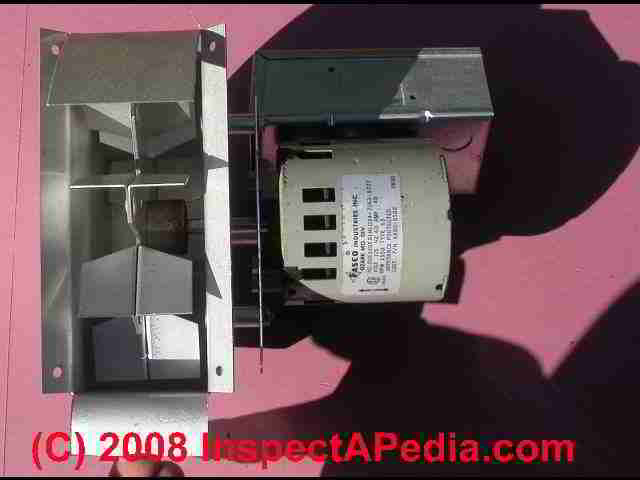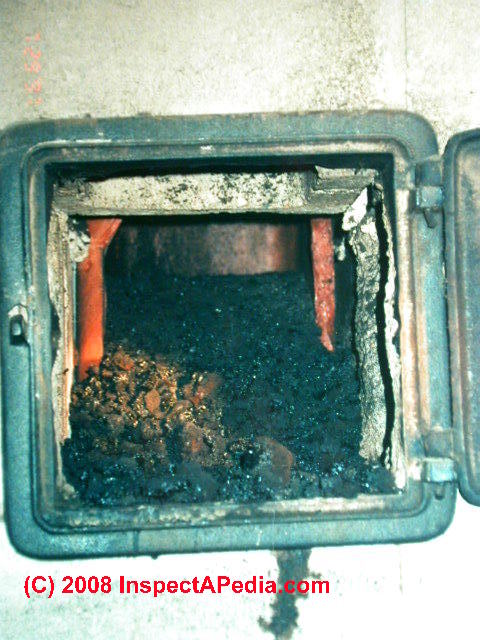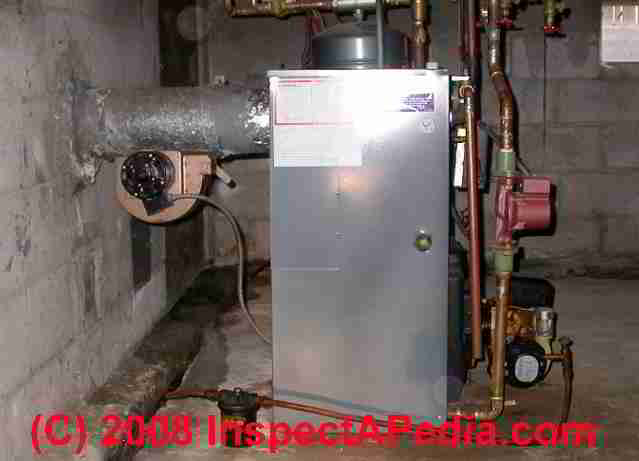 Guide to Installing & Inspecting Draft Inducing Fans
Guide to Installing & Inspecting Draft Inducing Fans
on Oil Fired Heating Equipment
- POST a QUESTION or COMMENT about bad draft on heating equipment & the use of draft inducer fans
Draft inducer fans & blowers:
This article discusses the use of induced-draft equipment
We provide a draft inducer fan guide: Here we explain Draft Inducers or Draft Booster Fans installed on oil fired heating equipment.
We also describe why you might need a draft inducer, how they work, and how a draft inducer is installed. We provider questions & answers about troubleshooting heating equipment draft, chimneys & flues, & draft inducers.
InspectAPedia tolerates no conflicts of interest. We have no relationship with advertisers, products, or services discussed at this website.
- Daniel Friedman, Publisher/Editor/Author - See WHO ARE WE?
Draft Inducer Fans for Problem Chimneys & Vents
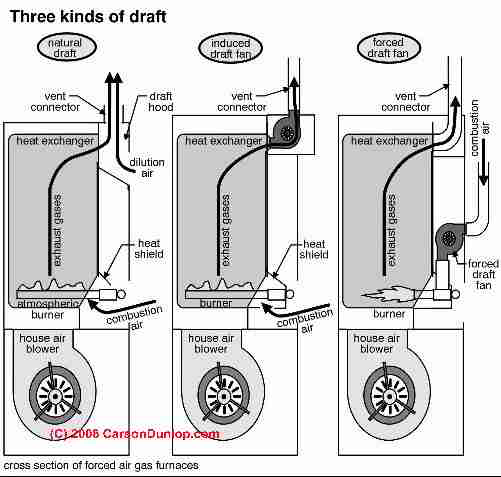
This article series answers most questions about central heating system troubleshooting, inspection, diagnosis, and repairs.
We describe how to inspect, troubleshoot and repair heating and air conditioning systems to inform home owners, buyers, and home inspectors of common heating system defects.
Details about draft control on oil fired heating systems, including furnaces or boilers, are discussed
at DRAFT REGULATOR, DAMPER, BOOSTER barometric dampers on oil fired equipment.
Details about draft control for gas fired heating systems, including furnaces or boilers, are discussed
at DRAFT REGULATORS / HOODS GAS HEATERS On gas fired equipment.
Our sketch at above left, courtesy of Carson Dunlop Associates, illustrates the three types of draft that may be found at chimneys and heating appliances: natural draft, induced draft by a fan blowing up a chimney, and forced draft by a fan blowing combustion air into a burner assembly.
[Click to enlarge any image]
This article discusses the use of induced-draft equipment.
The articles at this website describe the basic components of a home heating system, how to find the rated heating capacity of an heating system by examining various data tags and components, how to recognize common heating system operating or safety defects, and how to save money on home heating costs.
We include product safety recall and other heating system hazards.
Draft inducers are special fans that are installed in the flue vent connector (or sometimes in the chimney) used to vent a heating boiler or furnace. Most often we see these installed on oil-fired systems at which the technician was unable to obtain sufficient natural draft for proper oil burner operation.
Watch out: If an oil burner lacks adequate draft it will not operate properly, leading to soot clogging, more costly heating bills, back pressure in the combustion chamber, and possibly unsafe heater operation.
The draft inducer fan shown in our photo was found in our garage of left-over stock from our heating service days. This model, the Tjernlund DJ-3 Draft Inducer Fan is sold by Tjernlund in St. Paul, MN, and the photo shows the essential parts of this draft inducer:
- An electric motor (this one made by Fasco)
- A blower assembly of fan blades driven by the motor and designed to project into a metal flue pipe or flue vent connector
- An electrical junction box to connect the motor to the oil burner controls to turn the fan on and off when needed
- A metal shroud around the fan assembly
The draft inducer fan motor and wiring need to be adequately protected from the heat of the oil burner combustion gases, that's why you wouldn't try to make one of these at home out of an old computer fan or stereo system fan.
When is it not appropriate to install a draft inducer fan?
Be careful; it would be a mistake and possibly dangerous to install a draft inducing fan to boost oil burner draft to solve a venting or backpressure problem before the cause of that problem is accurately diagnosed.
For example, if the oil fired appliance draft is poor because the chimney is blocked, or because the appliance itself is blocked with soot and debris, or because there is inadequate combustion air, the draft inducer fan might make the problem seem to go away, but at the risk of creating unsafe conditions in the heating system.
In our photo of an oil fired heating boiler has a draft inducer fan installed. The draft boosting fan is that mechanism you see on the under-side of the flue vent connector to the left of the boiler.
If this boiler is venting into a chimney that is really right at the wall where the flue vent connector enters the block wall, it's a very short flue run and we would not expect a draft problem.
Something must be seriously wrong with the boiler or with chimney itself to have induced the technician to install a draft inducer fan on this heating system.
When Might We Need to Install a Draft-boosting Draft Inducer Fan?
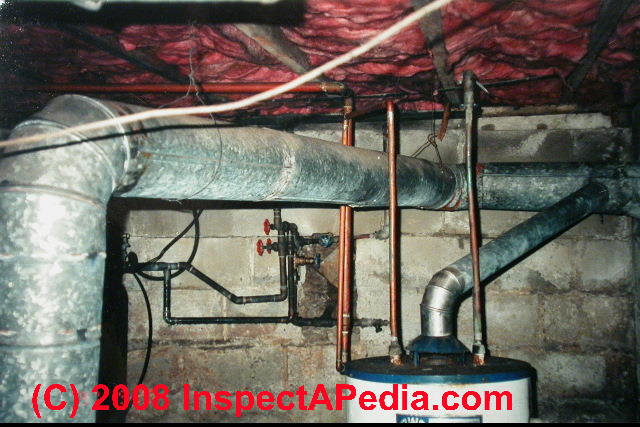
But where the flue vent connector run-length is abnormally long or tortuous it may be difficult to get good draft, or where the chimney size itself (to which the flue vent connector joins) is too big or too small, the use of a draft inducer might be permitted.
Watch out: the connection of smaller and larger diameter flue vent connectors together athead of the chimney such as shown in this photo is unsafe and improper.
See details at SHARED CHIMNEY & FLUE HAZARDS
Check with the fan manufacturer and a qualified HVAC service technician before asking that one of these fans be installed.
In the photo shown here we have a long metal flue run - we cannot see the end of it, and the flue is shared, and there is no barometric damper installed - we suspect there is poor draft at this installation.
We've installed draft inducer fans in a few cases where the building chimney design was just too difficult to get good venting by natural draft.
For example we encountered a 12' long horizontal chimney run through masonry placing the boiler too far from the vertical chimney flue for good draft.
But in general, before installing a draft inducer we should make sure that the chimney is safe, not blocked, and that the heating equipment has been properly serviced and adjusted first.
You might discover that someone simply left open the ash pit door on a heating system's chimney (photo above) - all that may be needed to improve the draft could be closing that little door!
At the chimney cleanout shown here we see a bit of debris that has collected at the bottom - which could be normal depending on what flue is being served and how long since the chimney was cleaned.
But if leave this door open not only do you nearly eliminate the chimney draft needed by the heating equipment, you are also creating a fire hazard, a fire spread between floors hazard, and a possible point of release of combustion gases into the building.
Close the little door.
How is a draft inducer fan installed?
A rectangular opening is cut into the metal flue pipe at a suitable location - usually close to the heating equipment since that makes wiring easier. The draft inducing fan comes with a paper template showing the size of the opening to cut.
The fan is mounted to the opening on the metal chimney or flue pipe so that its blades project into the flue, and so that when the fan motor runs it's pushing exhaust air away from the heating equipment and towards the chimney.
We've seen people install these fans in fireplace chimney flues in an effort to improve a fireplace that has inadequate draft, but we can't say if the manufacturer would approve that installation. There may be hazards due to creosote and other deposits from a wood-burning fireplace when one of these fans is used.
A note from Tjernlund informs us that draft inducer fan model DJ-2 has been replaced by Model DJ-3 and that all references in instructions to DJ-2 fans apply to DJ-3 models too.
...
...
Continue reading at COMBUSTION AIR DEFECTS or select a topic from the closely-related articles below, or see the complete ARTICLE INDEX.
Or see DRAFT INDUCER FAN FAQs, diagnostic questions & answers posted originally at this page.
Or see these
Recommended Articles
- AUTOMATIC VENT DAMPERS
- CHIMNEY DRAFT & PERFORMANCE
- CHIMNEY CODES & STANDARDS
- COMBUSTION AIR REQUIREMENTS
- DRAFT REGULATOR, DAMPER, BOOSTER
- DAMPERS & DRAFT REGULATOR TYPES
- DRAFT REGULATORS / HOODS GAS HEATERS
- DRAFT INDUCER FANS
- DRAFT MEASUREMENT, CHIMNEYS & FLUES
- DRAFT REGULATOR SOOT INSPECTION
Suggested citation for this web page
DRAFT INDUCER FANS at InspectApedia.com - online encyclopedia of building & environmental inspection, testing, diagnosis, repair, & problem prevention advice.
Or see this
INDEX to RELATED ARTICLES: ARTICLE INDEX to HEATING SYSTEMS
Or use the SEARCH BOX found below to Ask a Question or Search InspectApedia
Ask a Question or Search InspectApedia
Try the search box just below, or if you prefer, post a question or comment in the Comments box below and we will respond promptly.
Search the InspectApedia website
Note: appearance of your Comment below may be delayed: if your comment contains an image, photograph, web link, or text that looks to the software as if it might be a web link, your posting will appear after it has been approved by a moderator. Apologies for the delay.
Only one image can be added per comment but you can post as many comments, and therefore images, as you like.
You will not receive a notification when a response to your question has been posted.
Please bookmark this page to make it easy for you to check back for our response.
IF above you see "Comment Form is loading comments..." then COMMENT BOX - countable.ca / bawkbox.com IS NOT WORKING.
In any case you are welcome to send an email directly to us at InspectApedia.com at editor@inspectApedia.com
We'll reply to you directly. Please help us help you by noting, in your email, the URL of the InspectApedia page where you wanted to comment.
Citations & References
In addition to any citations in the article above, a full list is available on request.
- [1] "Instructions for Installing FIELD Type AF Barometric Draft Controls," Form No. 31 DC 30666, Field Corporation, Mendota, IL 61342, web search 04/02/2011, original source: http://www.fieldcontrols.com/pdfs/04592700.pdf, Field Controls, Kingston, North Carolina 28501, Tel: 919-522-3031
- [2] Tjernlund Draft Controls, A Series (single action for oil, solid fuel, and fan-assisted gas burners) and B Series (double action for gas heating appliances), web search 04/02/1011, original source: http://www.tjernlund.com/Tjernlund_8500490.pdf , Tjernlund Products, Inc., 1601 Ninth Street, White Bear Lake MN 55110-6794, Tel: 651-426-2993 or 800-255-4208 website: www.tjernlund.com Email: fanmail@tjfans.com
- In addition to citations & references found in this article, see the research citations given at the end of the related articles found at our suggested
CONTINUE READING or RECOMMENDED ARTICLES.
- Carson, Dunlop & Associates Ltd., 120 Carlton Street Suite 407, Toronto ON M5A 4K2. Tel: (416) 964-9415 1-800-268-7070 Email: info@carsondunlop.com. Alan Carson is a past president of ASHI, the American Society of Home Inspectors.
Thanks to Alan Carson and Bob Dunlop, for permission for InspectAPedia to use text excerpts from The HOME REFERENCE BOOK - the Encyclopedia of Homes and to use illustrations from The ILLUSTRATED HOME .
Carson Dunlop Associates provides extensive home inspection education and report writing material. In gratitude we provide links to tsome Carson Dunlop Associates products and services.


